Tree pruning involves shaping a tree to make sure it stays looking good or to increase the tree's ability to complement its environment. Tree pruning, on the other hand, serves to ensure that the tree remains in good health and grows as intended. If you're a homeowner who takes care of your garden, you've probably considered pruning and trimming trees before. Both are excellent services within the landscape industry.
Pruning is used to remove unnecessary branches. Trimming, on the other hand, promotes healthy growth. Both services are carried out at different times of the year, using very different equipment, to provide better aesthetics and a healthier landscape. However, understanding the difference is crucial.
Pruning helps protect against pests and diseases, and promotes strong growth. It mainly consists of removing dead, diseased and loose branches that prevent trees from blooming. We also remove any growth that interferes with other parts of the plant, such as branches that cross each other. Trees are living organisms and must be cared for.
People care for trees by pruning, cutting and pruning. Each tree is different, and its history and environment determine its care. You will find that trimming, pruning and cutting are used interchangeably, but there are differences in implementation time. The terms pruning and trimming are often used interchangeably, but for most it is surprising that there is a difference between the two.
When you are removing dead, loose or infected branches or stems from your respective plant, you are pruning. Trimming, on the other hand, occurs when overgrown plants are being cut. Below are some of the many benefits of regular pruning and trimming. Pruning is done less often than trimming, since it usually only needs to be done every two or three years.
Usually, deciduous trees (maples, oaks, elms and others) require more frequent pruning than evergreens because they grow much faster. If you remove more than 20% of the foliage in a pruning session, Webb said you run the risk of damaging your plant. In addition to promoting a clean look, trimming relieves excessively dense shrubs that can prevent sunlight and moisture from reaching the landscape. If your goal is to increase flowering capacity, prune immediately after the flowering cycle of a tree or shrub.
Understanding the difference between pruning and pruning can help you determine if you need to hire a tree care professional. Usually, evergreens are not pruned as often because they have less growth, but if there are dead or dying branches, they may need to be pruned more often. Trimming can be done for aesthetic or health reasons, but the important distinction is that the plant is overgrown and only enough is being taken to return it to its correct size or shape. If you own a house with a garden, chances are good that you have considered pruning trees or pruning them before.
By understanding the difference between the two, you can make informed decisions that directly affect the health and beauty of your trees and shrubs. However, the questions that many gardeners ask may concern the difference between pruning and trimming, and what is needed. Although the terms are sometimes used interchangeably, pruning and trimming have different applications and functions, each with its own equipment and schedules. When a plant is trimmed, the remaining foliage grows faster and thicker than if the plant were not trimmed.
TreeNewal has the services of certified arborists, who will guide you on the best time to prune, prune or cut your trees.
tree pruning





